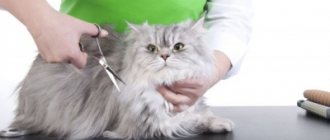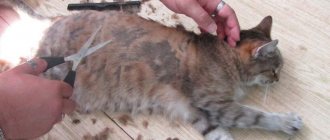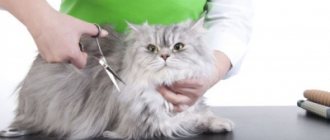Like all living beings, cats can experience stress and nervous tension.
There are many reasons, as well as options to solve the problem. Every owner should know how to calm a cat at home using improvised means or with the help of a specialist.
Almost all causes of nervous excitement, fear or panic in cats are due to the fact that the animal does not know how to react to changed conditions, feels uncomfortable in them and cannot help itself.
Signs of aggression in cats
The reaction to stress manifests itself differently in cats; an inexperienced owner may not immediately recognize fear in the animal’s behavior.
When cats behave nervously:
- lick the skin on one side of the body (one paw, one side);
- calm themselves by making loud purring sounds;
- become completely indifferent to their favorite food or become overly gluttonous;
- They begin to gnaw on various objects and chew indoor flowers.
In case of severe fright due to a loud sound or the appearance of a dog, pets:
- they freeze in place, flattening their ears, tucking their paws and tail under them;
- attempt to escape;
- trying to hide in a dark, secluded place.
During an attack of aggression, small predators begin:
- arching the back to look larger, inflating the tail and hair on the body;
- hiss loudly, snort, howl, showing his teeth;
- look closely at the object that causes aggression;
- rhythmically whip the tail over the body, twitch it;
- hit an approaching object with the front paws with claws extended.
If a panic reaction occurs (if the cat was unable to hide or protect itself), the animal experiences:
- copious flow of saliva, similar to foam;
- loud scream, heartbreaking meow;
- involuntary urination.
Why does a cat yell, list of reasons
Before looking for ways to solve the problem, you need to find out the reason for this cat’s behavior, and there are many of them.
shutterstock
Hormonal "storms"
One of the most common reasons why a cat yells day and night is hormones. Absolutely all uncastrated males “sin” this during the period of sexual arousal. It is very difficult to tolerate wild howls. How, in fact, to calm a cat if he is yelling for this reason.
Health problems
Sometimes a cat yells because of health problems, experiencing pain or other physical discomfort. Older animals may vocalize due to:
- Alzheimer's disease;
- serious nervous system disorder.
Seals also scream when they are injured during a fight or an unsuccessful jump. Other causes include worms that cause acute pain in the intestinal area, urolithiasis, etc.
The cat needs attention or food
Some cats, who feel the urge to eat in the middle of the night, also scream heart-rendingly, as if they are being slaughtered. They will walk around the owner's bed until he wakes up and wanders to the refrigerator. Such antics should be nipped in the bud. Who knows what this blackmailer wants? It’s better to endure the yelling a couple of times than to listen to it for many years and not sleep properly.
shutterstock
Anxiety or sadness
If a cat has been neutered, no diseases have been identified, and everything seems to be fine, but he yells and becomes somehow agitated, you should think about it. Perhaps the animal has a presentiment of something. For example, some natural disasters or other troubles. Cats tend to “anticipate” this, and often they save entire families.
A mother cat’s longing for her weaned babies is often manifested in a heart-rending scream, especially if at the time of weaning they were still very tiny. Animals, like people, can experience mental anguish. Their crying is not a reason for anger, but for sympathy.
Reaction to owner behavior
Sometimes cats yell if they are unhappy with their owner's behavior. For example, the owner shows cruelty or complete indifference to his pet. So the animal rebels. Some people are better off not having animals so as not to torture each other.
How to identify the cause of anger in a cat
Domestic cats, unlike dogs, have retained many of the qualities inherent in wild animals. Instinct tells them that danger can come from any object.
Pain inadvertently inflicted on a cat by a person leads to the idea that he poses a danger.
What can cause panic and aggression in an animal:
- moving, unfamiliar surroundings;
- the appearance of new things, other animals in the house;
- strangers (especially if they try to touch or stroke him);
- household appliances that make loud sounds (vacuum cleaner, electric meat grinder, etc.);
- poor health, illness;
- excessive affection from a person;
- games with children if the latter begin to cuddle the pet.
Methods of influencing a cat
Cats can scream not only because of the onset of sexual heat, so it is necessary to respond to cat singing
By screaming, a cat attracts a person's attention. Sometimes this may indicate health problems
Therefore, aggressive behavior and frequent screams should be a signal for an examination; perhaps the cat is sick and needs treatment.
If no deviations in health are identified, it is necessary to take measures to calm the animal and the whole family. You can use improvised means, hormonal or sedatives, and surgery. Let's analyze each method in detail.
People's recommendations
The most important thing is to keep cats away from the house and prevent the cat from seeing them.
If two pets of different sexes live in the house, mating will happen sooner or later. Therefore, it is necessary to resolve the issue of castration or sterilization of at least one of them, otherwise there will be a problem with placing the offspring in good hands.
During heat, it is better to remove the cat from the female’s sight: take him to the dacha, send him to stay with his grandmother in the village, ask friends to keep him for a week with them. But this is not a solution. A cat can scream every two weeks, but a cat cannot live in eternal wanderings.
One method to quickly calm the cat down is to place a warm heating pad next to your cat. The heat has a calming effect, relieves spasms, and the cat will stop screaming for a while. This way you can stretch out the time until the morning, and then decide the future fate of the cat.
Not all cats like to bathe, so an unscheduled bath can have a beneficial effect on behavior. The pet will be busy with water procedures, then licking its fur and will temporarily stop its inviting cries of love for the opposite sex.
However, literally the next day she will remember the natural need for love and affection, wriggling and purring will begin with a vengeance. If your cat screams at night and you don’t have time to bathe, you can simply spray the fur with water. Having taken care of her appearance, the fluffy beauty will shut up for a while and let you sleep until the morning.
During the day, a game will help distract you from thoughts about the groom. You can tie a candy wrapper to a rope and run with the cat along the corridor, you can come up with entertainment with a laser pointer or a sunbeam
During play, the animal switches attention and is distracted from thoughts about mating
But no one can guarantee a good night. Even when exhausted after active games, the pet can scream at the most inopportune moment, for example, at midnight. There is only one way out - dousing with water.
Science has proven that animals love music. Classical works calm not only people, but also animals. You can experiment with your cat by playing soft classical music.
Cats are wonderful actresses, so when they see a person they begin to scream and squirm much more strongly. The lack of appreciative spectators leads to the fact that the concert ends quickly. If your cat starts to get tired of screaming, you can try isolating it in a separate room where no one in the household is present. In just a quarter of an hour, the purring will stop and the cat will go to sleep.
Features of the use of sedatives
Often, taking sedatives is a way to normalize a cat’s condition in the period before castration, a long trip, a visit to a veterinary clinic, or home renovations.
Sedative drugs have two types of action: cumulative and immediate. In the first case, you should start giving them to the animal 10-14 days before the expected event.
Often taking sedatives is a good way to normalize a cat’s condition.
Instant-acting drugs act quickly, but are harmful to the body; such drugs should not be used too often.
Popular herbal preparations:
Chemical sedatives:
Important! Before using any sedatives, consult a veterinarian.
What to do when stress is planned and inevitable
Before planned stress (moving, bringing a new pet into your home), you should start giving your pet sedatives prescribed by a veterinarian in advance. The effect of hormonal drugs, for example, is cumulative. It will not be possible to achieve the desired effect in two or three days.
If you have already had a sad experience of traveling with a pet (for example, the animal took a long time to come to its senses after a trip), then you should consult a veterinarian about the use of more potent drugs. You cannot give them to an animal yourself. The veterinarian will ask you what exactly the problem was and, based on this, will select the best option for the remedy.
Is Valerian safe?
Important! The herb valerian has long been considered a mild sedative of plant origin, but not for cats.
Valerian acts on cats as a stimulant that can increase aggression, sexual desire, and hallucinations. In case of overdose, an epileptic seizure may develop.
Catnip is also not a sedative for cats.
Medicines
Calming tablets are the most radical way to correct the hormonal levels of “walking” cats. Conventionally, they can be divided into two main types:
- Hormonal. They block sexual arousal, interrupting estrus. There are many drugs of domestic and foreign production on sale, the most popular of which are “Stop Intim”, “Gestrenol”, “Sex Barrier”, “Anti Meow”, “Pillkan”.
- Mild sedatives, including homeopathic ones. Tablet drops “Cat Bayun”, “Feliway”, as well as “Suprastin” or regular “Valocordin” help relieve emotional and physical stress.
Ferromones. The synthetic ferromone “Feliway”, produced in the form of a diffuser, shows itself well in practice. The device is connected to an outlet and operates within the entire apartment or a separate room (depending on the area). One package is designed to be used for approximately 4 weeks.
You can now view the current price of sedatives and buy them right here:
Which of the above methods will work can only be determined by trial and error. The main thing is to be patient and understand that the cat is not engaged in “sabotage” on purpose, but at the call of nature.
- How many days does a cat walk?
- At what age do cats start walking?
- How many days does a cat ask for a cat?
How to suppress aggression and calm down
You can quickly suppress aggression in an adult animal like this:
- Wear thick clothes and thick gloves, take a blanket and wrap the aggressive cat, holding him in your arms until he is completely calm.
- Spray the cat with water.
- Leave the animal indoors for a while, during which time the anger will gradually subside.
- Don't look the cat in the eye.
- Prepare in advance a place in the room where the pet can hide.
- Do not punish your pet - punishment will only provoke a repeated attack of anger.
Medicines to calm cats
When a cat wants a cat, every owner inevitably thinks about how to calm him down. The first thing that comes to mind are medications designed to dull the sexual instincts of an animal. Now their range is simply huge, but before choosing one in particular, it is better to consult a veterinarian.
Many owners wonder how these same drugs affect the health of their pet. However, even outstanding specialists cannot answer this question unequivocally. After all, their main effect is the regulation of hormones. At the very least, you shouldn’t abuse drugs. They should be given directly when the cat wants a cat. At this moment, the owners no longer think of how to calm him down, and radical measures need to be taken.
How to calm an active kitten
When a kitten is not sleeping, it always shows increased activity and is full of energy. Every day the little animal grows, learns, and encounters something new. Everything unknown can cause sudden fear or an attack of aggression in the baby.
To calm down an angry kitten or calm a frightened one, you should try using the following methods of influence:
- Relieve excessive activity or stress through games.
- Use interesting toys that can captivate a small pet (a furry mouse, a ball with a bell on a long rope), putting them out of reach the rest of the time.
- Do not stop the game abruptly, wait until the kitten is really tired.
- Offer your baby a favorite food or treat at the end of the game.
- Ignore the kitten if the behavior becomes aggressive, end the game immediately.
- Prepare a comfortable place for your little fidget to sleep (cardboard box, basket, fur house).
Aggression caused by irritation
Sometimes a cat's aggression is caused by irritation. This happens rarely and appears completely unexpectedly. For example, you are petting a cat, and its calm reaction suddenly gives way to aggression. There are no apparent reasons, but an aggressive cat is preparing to attack anyone who happens to be nearby.
It is noteworthy that aggression resulting from irritation is most often suppressed. That is, the cat is aggressive, but he does not want to harm his owner. It manifests itself like this: an aggressive animal rushes at a person, but its claws are hidden, or an aggressive cat bites its owner, but the bites leave practically no marks on the skin.
The main sign of irritation is tail hitting. If the cat was calmly accepting your affection all the time, and at one point began to beat its tail on the floor, you should know that it is irritated. Sometimes the cat perceives measured strokes on the stomach differently than before and begins to frantically beat the owner with its hind paws. Do not think that your pet is unpleasant to receive affection from you. Just like people, animals have bad moods. Leave your pet for a while and the aggression will disappear.
How to calm an adult at night
Cats are nocturnal animals.
To socialize their behavior and sleep peacefully at night, you should:
- feed your pet before bedtime;
- play active games in the evening;
- Make sure the litter box is cleaned and fresh water and some dry food are provided.
If the actions do not bring the desired result, you should remove the cat from the bedroom, preparing a cozy place for her to sleep in another room.
Play aggression
Sometimes the reason for a cat’s aggression lies on the surface: cats are playful by nature and aggression in some cases is increased playfulness. The main sign of playful aggression is suddenness.
© shutterstock
If an aggressive kitten is actively playing with a ball or jumping around the corner at one of the household members, be sure that the fluffy one is simply bored and wants to have fun. Sometimes overly playful cats jump on their owners or cling to the top of the curtain. A particularly active and aggressive kitten rushes around the room sideways, arching its back, sharply slowing down my direction. In rare cases, an aggressive cat may try to bite or scratch during play, but in most cases such pranks do not cause any harm.
You should not try to calm the cat down, because it may become offended and its aggression will increase . It is best to take time and play with your pet. Cats love to hunt, so you can play chase or hide and seek.
How to trim your nails calmly
There is the simplest way to calm a cat before trimming its claws: you need to attach a pair of clothespins (with weak compression force) to the scruff of the neck.
You need to prepare in advance for a long trip by train, car or flight.
This is where psychology comes into play; in childhood, a cat carries a kitten, holding this place with its teeth; if there is compression in the nape area, the animal instinctively calms down and relaxes.
Painful aggression
Aggression is often caused by pain. During illness, an aggressive cat is hostile to any touch. The animal stops reacting adequately and may perceive any action as an attack.
Often capricious and aggressive cats become so because someone offended them . Just like people, cats can be vindictive. That is, if someone hurt a cat, then in return she will also try to hurt her.
Sometimes people can offend a cat and not notice it, but the animal remembers this and another time, seeing an irritated or angry person next to it, it attacks without warning. An aggressive pet is the first to fight so as not to get hurt.
How to calm your pet on the road
For a long trip by train, car or flight, you need to prepare in advance . If the date of the trip is known, it is worth starting taking cumulative sedatives; if the trip was not planned, you can give your furry pupil a medicine that instantly affects the nervous system.
But the most important thing is to get a comfortable carrying bag for your trip. You need to purchase it in advance so that the cat gets used to the new thing. It is necessary to allow the cat not only to examine the bag, but also to sleep in it for several days. Several diapers for the toilet, clean water, dry food - items necessary on a long trip.
When can you use sedatives on your cat?
Cats are amazing creatures with sensitive nervous systems. For them, the cause of stress and the development of neurosis can be a change in their usual environment, especially at a young age, as well as puberty. Often cats begin to show aggression if a new pet appears in the house. The reason for stress in furry animals can be childbirth and the period after birth, associated with the fear of losing kittens. Sedatives have a cumulative effect, and to prevent the occurrence of an unpleasant condition, the cat should be given the drug two weeks before the intended trip.
Sedatives should be given to cats with caution. In some cases, the use of a natural-based sedative may be sufficient; in other situations, the use of chemicals or tranquilizers is required, which must be prescribed by a veterinarian
Symptoms of increased anxiety in a cat include frequent licking of fur and marking territory, aggression towards the owner, family members and oneself, hyperactivity, obsessive movements of the tail, head or paws. A cat's nervous state may be indicated by constant meowing, tearing out fur or sucking tissue, a fixed gaze, gluttony followed by vomiting, and hunting for non-existent prey.
The use of sedatives can reduce stress in your pet and make a difficult period for him more harmless and easily overcome.
Cats are given sedatives for:
- change of place of residence. Cats do not tolerate changes in their environment or home. This is stressful for them, and it takes them some time to adapt to their new place of residence;
- fears and increased anxiety. The cause of excessive nervousness is noisy guests, small children who run after the cat and want to play with it. A cat that can barely tolerate the affection of its owner, with fear and hostility, succumbs to the sometimes unkind stroking of strangers. She doesn’t understand what’s going on around her, what these strangers want, and she develops fears and anxiety. In this case, a sedative is an excellent way to prevent depression in a pet.
- nervous disorders. In some cases, cats experience a progressive nervous or mental disorder without clearly defined causes. In addition to the other characteristic symptoms mentioned above, the pet may experience involuntary head twitching and sudden jumps. Such disorders require examination at a veterinary clinic and the use of not only sedatives, but also medicinal drugs;
- participation in exhibitions, visits to a grooming salon and a veterinarian, vaccinations. Preliminary intake of sedative drops or tablets will allow you to organize the proposed activities more painlessly and without damage to the cat’s nervous system;
- intensive marking of the apartment territory by the cat. Certain sedatives help reduce the desire of cats to leave marks on all corners throughout the apartment, and also suppress the hormonal explosion.
When traveling by car or bus
Moving in any type of vehicle is extremely stressful for a cat. The reasons for depression in pets are a large number of unfamiliar people, unusual smells, noise, hum, and shocks in transport. Panic can also be caused by the owner’s nervous state associated with a long journey, because cats are able to detect mood changes and anxiety in their loved one.
During the flight
It is not recommended to sedate your cat before a flight without the advice of a veterinarian, as this will lead to a decrease in blood pressure, which is dangerous during the flight. When flying with a cat, you can use Feliway, which helps reduce anxiety in cats. Buprenorphine, Gabapentin and Alprazolam are also effective and are also used to reduce anxiety in cats during travel.
After sterilization
Sterilization causes changes in hormonal levels and causes anxiety and aggressiveness in the pet. This condition is also observed in cats during the period of sexual desire and estrus. Special sedatives help eliminate the symptoms of hypersexuality, depression and irritability as a result of changes in hormonal balance. In this case, experts recommend the use of natural-based drugs.
Signs of aggression in cats
Before “going berserk,” your pet gives clear signals about an upcoming burst of aggression. How to determine that an animal is preparing to attack:
- angry grin;
- growling and hissing;
- mustaches and ears are pressed down;
- dilated pupils;
- wool standing on end;
- a crooked, awkward pose;
- looking directly at the target or clearly avoiding eye contact.
The cat looks angry, irritated, on edge, as if he is unable to relax, and explodes at the slightest provocation. Almost anything can provoke such a release of negativity - from the fright of an awakened animal to serious changes in the environment or place of residence. For example, it is almost guaranteed that a cat will “go mad” when there are a large number of strangers, the appearance of a new pet, or when moving frequently.
Aggression can be intraspecific (cat-cat) and interspecific (cat-another animal, cat-human). Also, sometimes the pet attacks and tears objects.
Sometimes the pet attacks and tears objects
The condition can appear suddenly and plunge the living object of attack into psychological shock - the same as the one in which the cat itself is.
Animal psychologists say: signs of aggression in cats very often mask fear and severe stress in which the animal itself is. The cat wants to, but cannot find a way out of the situation and understand it. He can be helped by simply understanding what led to the aggression.
Helping your cat cope with stress
Cats have a hard time with changing their environment; it is stressful for them. What to do if you can’t avoid a trip to the country, a trip to the veterinarian or hairdresser?
Two necessary conditions for the trouble-free movement of a cat are a calm owner and a comfortable carrier, which should become a second home for the animal. You cannot carry the animal in your arms.
Before traveling, prepare a mobile shelter for your cat - a comfortable carrier with hard walls, soft bedding and ventilation. For sound insulation and warmth, the carrier is wrapped with soft cloth on top. The cat should perceive the mobile house as a shelter where your pet can hide, say, after a doctor’s examination and calm down.
Required conditions after stress - peace and quiet
Habit plays an important role. If you plan to often take your cat with you on trips, you need to gradually accustom it to this from childhood. A pet that regularly travels in its portable home will not create problems during its next voyage.
Medicinal methods
In order to prepare the cat for stress, which cannot be avoided, special medications based on herbal ingredients are used. For example, Fitex contains hops, motherwort, valerian, and Baikal skullcap. In addition to these herbs, Stop-Stress contains phenibut. The drug Kot Bayun is available in the form of infusion and tablets. It includes extracts from a dozen medicinal plants.
A calming collar with pheromones will help the animal cope with a stressful situation
Table: Calming products for cats
| A drug | Active substance | Release forms | Dosage | Effect | Price |
| Stop stress | Active ingredients: phenibut (aminophenylbutyric acid) + extracts of medicinal plants (catmint, motherwort, hops, Baikal skullcap). | Drops and tablets | 1 drop per kg of animal body weight twice a day; or 0.25 tablets with a weight up to 5 kg, 0.5 - with a weight from 5 to 10 kg; for body weight more than 10 kg, give a whole tablet. | Long lasting calming effect | 145 rub. |
| Fitex | Plant origin. The composition of the drug includes the following extracts: - thick extract of valerian officinalis (valeriana officinalis) - dry extract of motherwort (leonurus quinquelobatus gilib) - dry extract of common hop (humulus lupulus) - dry extract of Baikal skullcap (scutellaria baicalensis georgi) 1 ml The drug contains 100 mg of the sum of dry and thick extracts. Does not contain sugar or ethyl alcohol. | Drops | 3–5 drops three times a day | Mild sedation | 130 rub. |
| cat Baiyun | Only plant components, contains aqueous extracts from plant materials: oregano herb - 0.45%, sweet clover herb - 0.23%, rhizomes with valerian roots - 0.23% and phytocomplex - 1.45%, containing extracts of flowers and fruits hawthorn, hop cones, motherwort herb, peppermint leaves, ivy grass, catnip herb, lemon balm herb, meadowsweet flowers, St. John's wort herb, thyme herb, cudweed herb, hillwort herb, nettle leaves, roots, rhizomes and herb of evasive peony , and as an auxiliary substance - distilled water - up to 100%. | Infusion and tablets | A single dose for infusion is 2 ml (half a teaspoon); for tablets - 2 pieces. Frequency of administration: 3–4 times a day. Tablets are used starting from the age of 10 months of the animal. | Long-term sedative effect: stabilization of the animal’s condition for 5–7 days | Drops - 132 rub. per package. Tablets - 115 rub. |
| Xylazine | The synthetic compound is a derivative of thiazine Xyl as an active ingredient in 1 ml contains 20 mg of xylazine hydrochloride, as well as excipients: sodium metabisulfite - 1 mg, citric acid - 10 mg, benzyl alcohol - 0.01 ml, sodium hydroxide (for pH correction = 5.0) and water for injection - up to 1 ml. | Injection | According to the instructions for use, 0.25 ml per 100 kg of weight is used for sedation; for sedation accompanied by muscle hypotonicity and analgesic effect - 0.5 ml; for immobilization and pain relief 1.0 ml; for long-term surgical intervention 1.5 ml (this dose is used only for adult animals). | Calming, analgesic, muscle relaxant | 630 rub. |
Photo gallery: sedative medications
No one is immune from stress and fear, not even cats. Each domestic cat has a unique character and temperament. No one knows how your pet will behave in an unusual situation. Only love, care and the right reaction will help owners of tailed pets find the right approach to their animal and help them cope with emotional turmoil.
How to identify the cause of anger in a cat
There may be several reasons why a cat can react so painfully to its surroundings, and they are not always obvious to the owner.
Fear
The main reason for the “brutality” of a cat driven into a corner by a difficult situation and not receiving support. Such an animal has no other choice but to attack. Any non-standard or unpleasant situation can cause fear - from a sharp sound and bright light to procedures in the veterinary office.
Fear makes an animal's behavior unpredictable
Veterinarians often observe classic aggression from fear. It looks like this:
- the cat shrinks into a ball and tucks its tail, trying to become as small as possible;
- the cat may urinate, defecate or mark;
- horror appears in the animal’s eyes, then anger comes.
Fear forces the animal to express the request with its entire body and behavior: “Leave me alone!” However, the stressful situation continues for various reasons, and the pet decides that he has only one way out - an attack.
- If possible, leave the animal alone;
- provide shelter (carrying, dark corner) until calm.
In the future, the cat needs to be gently removed from the state of stress and socialized.
The cat was friendly and calm, and suddenly began to hiss and rush at people and animals? Such behavior can be the cause of illness, even with seemingly convincing external signs of her health.
Aggression in a cat can be one of the signs of pain
There are diseases that occur without external manifestations, for example:
- epilepsy;
- toxoplasmosis;
- encephalopathy;
- hyperthyroidism;
- heavy metal poisoning.
It is necessary to check the pet's health - consult a doctor, do an ultrasound, take blood, feces and urine tests.
If you notice any abnormal manifestations, contact your veterinarian
An aggressive reaction can occur if a person, while caressing a cat, accidentally touches a sore spot. There are also cases of a cat attacking if the owner steps on its paw, or a child causes pain to the animal (pulling the tail, squeezing it). If a cat is over 12 years old, it may develop age-related diseases, for example, arthritis - you should handle an older pet with extreme care.
It is common knowledge that cats sometimes bite their owners' legs. This happens if:
- do not play with the animal;
- the cat survived on the street alone;
- the kitten was taken from the litter too early (before 3 months).
Unpleasant manifestations are “treated” with the help of education (teach the animal that bites and scratches immediately stop fun play and communication) or interactive toys that will keep the cat occupied for a long time.
A cat may bite its owner due to lack of attention
Claims to territory
Most often, this type of aggression occurs between cats, but can be directed at a person or another pet. A territorial war is almost guaranteed to break out if you have a couple or more uncastrated animals of the same sex living in your home.
- take animals to a veterinarian for spaying or neutering;
- place bowls of food in different rooms or corners;
- Buy each animal a separate tray.
To avoid conflict between cats, each has its own bowl
Protection of offspring
If the kittens are in danger (or appear to be), the mother cat may react inappropriately to people and other pets in order to protect her young.
By protecting the cub, the cat becomes a tigress
- do not disturb the cat and kittens unnecessarily;
- arrange a reliable and safe corner for the cat family;
- limit contact with people and other animals as much as possible for 2-3 weeks.
Reaction to affection
Maybe you touched a sore or, from the cat’s point of view, inappropriate place, or the cat has become overexcited and can no longer tolerate physical contact.
Before an act of aggression, a cat usually gives signals:
- meows;
- twitches skin;
- wags or beats its tail;
- stops purring;
- flattens ears or twitches them;
- crouches, trying to avoid touching.
Pay attention to your pet's signals and you will avoid an aggressive attack.
If you weren't careful, you'll get bitten out of turn
Sometimes a cat's aggression can be redirected . The animal heard a sharp sound, experienced pain, noticed an inaccessible stress factor, but does not understand the cause of the discomfort or cannot reach it and eliminate it. A classic case is when a cat sees another cat outside the window, but cannot go out and make territorial claims to it. Then the animal may attack a person or another pet, trying to get rid of discomfort.
In an emergency
Unfortunately, force majeure circumstances happen in life. The cat may be injured (falling from a height, fighting with another animal) and be in a state of shock. A completely unfamiliar cat may show aggression towards a person in defense of its kittens or food. In such a situation, the main rule applies - do not aggravate it!
To keep distance
It is permissible to stroke only your cat, but even in this case, caressing may not calm the animal, but anger it. No matter how much the owner wants to support his pet, it is better to leave the cat alone in a confined space (carrier, box, house).
Cats by nature are solitary animals, not pack animals. At times of severe stress, they are guided by instincts, and not by attachments acquired through life.
Keep calm
Like other pets, cats show empathy - they are good at feeling people's emotions.
If the owner is nervous or afraid (for example, before an upcoming operation), the pet begins to become stressed for this reason alone. That’s why sometimes it’s better to entrust an animal to an unfamiliar but absolutely calm person for the duration of the procedures in the clinic.
Radiate calm
You can try to calm the cat down by talking to it in a calm, quiet voice, as if lulling it to sleep. For aggressive individuals, you need to add more flattery to the monologue. Listing the cat’s virtues in a honeyed voice can easily distract a capricious young lady for a while.
If talking to your cat out loud is uncomfortable or seems stupid, you can try instilling your good intentions telepathically, focusing on your desire to help rather than harm.
Exercise caution
An angry cat can cause serious injury to a person despite its small size. It is necessary to minimize violent procedures, and if such cannot be avoided, try to secure the cat in advance (for example, in a special bag) while it is calm.
You need to have patience with representatives of the cat family. It is better to approach the animal over and over again than to go straight ahead, ignoring the pet's warning signs.
Switch attention
If aggressive behavior threatens a person or another animal, you should try to distract the cat. The best means of protection is a spray bottle of water. But it is not always at hand.
Trying to break up amicably is a good strategy. You need to make sure that you are not blocking the animal’s only exit from the room, or start retreating yourself. If the cat is ready to rush, throw the object to the side with maximum noise (a bunch of keys), this will give you time to escape.
How to calm a cat
The main recommendation is not to hit an animal in response to aggression. First of all, because he’s already feeling bad. In addition, cats are touchy and take a long time to understand the evil and injustice caused to them.
To calm your cat or remove him from a stressful place, you can pick up the animal. Wear protective clothing and throw a blanket or thick blanket over him. This measure is temporary, it can even anger the cat even more, but it is irreplaceable for a number of situations - for example, when you are in a public place.
Video - How to calm a cat
How to calm a cat when he's "mad"
- Spray water from a spray bottle. This will save your hands from scratches if the animal jumps on you. It also works well when a cat is fighting with another pet.
- Step back. Taking a few steps away from your cat will help reduce her stress levels. You can go into another room for 10-30 minutes, or provide this opportunity to the cat.
- Separate conflicting pets into separate rooms. The ideal option is to introduce animals gradually.
- Sit down or lie down on the floor. This will make you seem smaller and less dangerous to the animal.
- Don't make eye contact. Cats perceive direct gaze as a sign of aggression and imminent attack.
This beast really needs peace
When you are on the same plane, you are equal
Your main trump cards are patience and love. It will take a long time to develop trust, but you will achieve a harmonious, friendly relationship with your pet.
How to calm a screaming cat
Does your cat scream often and loudly? This reaction can be caused by several reasons.
- Disease. Age-related changes, psychological disorders, acute diseases - all this can provoke cat screams. Often the animal reacts with screams to helminthiasis and intestinal obstruction.
- Hunger and thirst. Check the animal's bowls - are there food and water in them? Change food and water or refill bowls.
- Lack of attention. A new pet, the birth of a child, or the constant busyness of the owners cause discomfort to the cat, and she tries to attract attention to herself.
- Lack of physical activity. Play with the animal and do not let it rest in the evenings.
- Hormonal surge. Sexual heat in a cat causes many imbalances in behavior. A day or night cry signals that the cat is ready and wants to mate. Castrate the cat, give him a sedative or ensure mating. You can read how to prepare a cat for castration in our article.
So far we have been talking about adult cats, but how to calm a kitten when he is angry? Animal psychologists advise gently holding the animal close, stroking it, and talking soothingly.
Nighttime screaming is especially annoying to owners and neighbors. How to calm a cat at night? There are no quick ways to calm an animal for a long time. A radical restructuring of the daily routine is needed.
Veterinarians' advice on how to calm a cat before bathing
How to calm a cat who wants a cat
A common reason for a cat's screaming and aggression is the desire to mate. It is not difficult to determine when a cat reaches puberty - the pet is “ready for love” between 8 or 10 months of life. How to determine that a cat wants a cat? Instincts become more acute at the end of winter and manifest themselves:
During the rut, a suffering cat can cause a lot of problems.
- aggressive attitude;
- hissing and loud meowing;
- reluctance to contact;
- biting and scratching;
- marking the territory.
How to calm the storm of cat hormones and what means to use for this?
- If possible, release the cat. He will satisfy his natural desire and return home. After returning, give him a bath, worm him, and take him to the vet if necessary.
- Give your animal a sedative or hormonal medication prescribed by your veterinarian. Proven options for tablets and drops for cats against partying: “Gestrenol”, “Stop-stress”, “Contrasex”, “Sex-barrier”, “Fitex”, “Cat Bayun”, “Libidomin”, “Stop-intim”.
- Have your cat castrated at the veterinary clinic. This method is long-term and most reliable.
Table. Sedatives for adult cats
How anxiety manifests itself
Stress in a cat can manifest itself in different ways and includes four main reactions.
Nervous behavior
The pet begins to purr and lick itself more often than usual; bald patches may then appear in these places. If there are no parasites on the fur, then such actions indicate overexertion. Sometimes licking is accompanied by a change in appetite - the animal either begins to eat too much or refuses to eat at all.
Trying to hide
The second sign that an animal is experiencing fear is its desire to crawl into a secluded place and not show itself until the irritating factor disappears. Most often, cats are frightened by loud noises, strangers, other four-legged animals, or new habitats.
Panic
The highest stage of manifestation of nervous overexcitation is a panic attack. In this state, the animal emits terrible screams, accompanied by profuse salivation. The fear may be so intense that involuntary urination or defecation occurs. In this case, the ears are pressed firmly to the head, the pupils are dilated, not narrowed. The cat shrinks and presses itself to the ground.
Aggression provoked by fear or pain
Any cat that is cornered will fear for its life. This is an animal instinct and it is very difficult to cope with it, even if you really want to. The animal may be in varying degrees of fear:
- If it is mild, the animal is wary, but can approach the object that frightens it and sniff it. In this case, there is simply no need to make sudden movements. The cat, having sniffed and realized that there is no threat, will calm down.
- With medium, the animal will behave very restrained and tense. You just need to gently support the cat, talk to it, and gently caress it.
- A severe degree of fright is accompanied by the animal throwing itself at everything that is nearby. The kitten gets angry, hisses, purrs angrily, and takes threatening poses. You shouldn’t even try to stop the animal and you shouldn’t even try to pick it up. You just need to leave the room until the cat calms down on its own. If the animal is afraid outside the home walls, throw a blanket over the cat, wrap it up and place it in a closed carrier.
A very strong degree of fear, when, simultaneously with anger, the cat begins to pee and poop, its eyes are dilated to the limit, and its mouth is open. This condition is dangerous both for the cat itself and for others.
The animal is at the limit, under no circumstances should you approach it and you need to protect your face - the pet may even jump. You won't be able to calm the cat down. You can just throw a box or blanket over it and leave it alone.
Aggression over territory
Territorial aggression can occur in any animal, regardless of gender. Attacks on the owners may be an attempt to become the head of the pack. The cat's biggest irritant is the smell of sweat. This can only be dealt with by castration or sterilization of the pet.
Aggression between species
A cat's anger can be caused by a fight for the attention of its beloved owner or food. The animal begins to claim the role of leader. This happens if two or more cats live in the house at once. Anger is explained by surges in hormones, competition, or a weakened “alpha” of the pack.
Man cannot cope with nature. All that remains is to let the cats sort things out among themselves and patiently observe what is happening, or to spay or neuter all pets.
Redirecting Aggression
A cat, angry at an inaccessible object or person, may begin to attack the one nearby who has fallen “under its paw.” Even after some calming, the animal will remain irritated for some time. There are only three options to calm your pet - castrate (sterilize), give a sedative, or simply isolate for a while in a separate room.
Overexcitement
The unreasonable anger of a cat is a rare phenomenon. The first unexpected paw strike becomes a warning before an attack. Perhaps the person touched something “sacred” to the pet, violated her personal space, or accidentally caused pain. Such aggression is also possible during games, when the cat is very naughty.
There are several options here. If this happens during play, you need to stop teasing the animal with your hands. You can use strings, balls and wind-up toys, etc. If this happened due to early weaning from the mother, it will help the cat to calm down if you give the pet more attention and affection.
Maternal malice
Maternal aggression is a case when a person should not even try to cope with it. An angry animal can not only attack, but also seriously injure you. The cat will fight to the death no matter what they try to do to it. The best way is to simply stay away from the kittens and the den, walk around and not try to get into it with your hands.
It happens that a cat that has given birth, even if left undisturbed, begins to attack its owners. In this case, you need to choose a moment and move the den with the kittens away to a quiet corner, darken the room slightly, and temporarily refrain from guests. If a cat is preparing to attack, you should not turn your back to it. You need to gradually retreat, while keeping your palms open. At this moment, you cannot even talk to the animal, so as not to provoke it into an attack.
Mating season
During the mating season, the cat becomes angry and starts yelling all day long. At the same time, it also marks the territory. The simplest advice on how to calm a cat when he wants a cat is to simply let the animal go. As soon as the male is satisfied, he himself will return home in a normal mood. You can give your pet one of the following sedatives:
- "Contrasex";
- "Stop stress";
- "Sex barrier";
- "Cat Baiyun";
- "Libidomin";
- “Stop intimacy”;
- "Gestrenol".
It is important to remember that it is better if the drug and dosage are prescribed by a doctor. Taking steroids creates a risk of hormonal imbalance and, as a result, the appearance of many diseases.
How to calm a small and active kitten - basic tips
Having your own pet is a dream that many want to make come true. A pet that you can take care of will become an excellent friend and ally.
When choosing a pet, many people prefer a young cat or dog. If the choice falls on a small kitten, it is desirable that it adapts well and adapts to home conditions.
But most often the kitten turns out to be too active and playful. There is no need to worry about this. If you pay due attention to discipline and education, an obedient and moderately calm pet will grow out of a hyperactive fidget.
Kitten activity
The behavior of a small representative of the cat family is very similar to the behavior of a small child. He also knows how to rage, play pranks, and disobey. An 8-week-old kitten may be more active than its one-year-old counterpart. But, as experts note, there are cat breeds that are hyperactive on their own and this is the norm for their character.
How to calm a kitten when he's mad
If it’s time to sleep, but you can’t calm down the kitten, here are some simple tips that will help your pet become more disciplined:
Play with him
To release some of the kitten's pent-up energy, an excellent solution would be to include him in play. A suitable option is an imitation fishing rod. By changing its direction and speed, you can create the impression of hunting prey. You can also encourage the kitten by making it run after the ball. But you shouldn’t use yarn for the game. This can lead to intestinal diseases in your pet. It is not the most suitable way to calm a kitten by including your hand and fingers in the game. This will provoke him even more.
Reward him with food
You should not leave food for your ward in the public domain. It will be better if you create conditions similar to those in the wild. For every labor there is a reward in the form of food. There are many devices on sale now that are labyrinths. To get to the food, the kitten will first have to locate it. After a good game and satisfaction of hunger, the kitten will definitely want to sleep.
Create conditions
Currently, pet stores offer a huge selection of cat houses. As you know, cats love high spaces from where they can observe. Additionally, tall spaces provide more room for exploration. If the house is equipped with shelves, a scratching post, and a hidden area, the kitten will happily mark its territory and release energy. An ordinary box can be a replacement for a purchased house, because cats like not only high, but also enclosed spaces.
Discipline him
It happens that a kitten is completely out of control and nothing helps to calm it down. In this case, you need to use suitable parenting methods. Growing kittens, like children, need a mentor and respond to strict and consistent discipline. Don't yell at him or hit him for bad behavior. He may remember this and be offended. If the kitten does not understand a calm tone, you should leave him alone in the room for a few minutes. It also helps to sober up a bully if you splash water on him or lightly flick him on the nose. You should not abuse such methods.
Calming a kitten will not be difficult. As in any business, it pays to put in a little diligence and patience. Perhaps the kitten is lonely and is trying to attract attention. In this case, you can get him a companion. In the new company, he will feel responsible and become calmer and more flexible.
Sources:
https://kotikdoma.com/uhod-za-koshkami/sredstva-uhoda-za-koshkami/kak-uspokoit-kota.html https://pets-expert.ru/kak-uspokoit-kota/ https://pristor .ru/kak-uspokoit-malenkogo-i-aktivnogo-kotenka-osnovnye-sovety/
What to do at home?
Once you have identified the cause of this behavior, there are a number of preventive measures you can take to help your kitty cope with the stress.
It is not necessary to immediately run to the doctor if such behavior is not caused by internal pain. You can figure out the reasons at home and make attempts to help the cat.
Comfortable conditions
You will need:
- Cardboard box or house.
- Separate room for privacy.
You need to leave the cat completely alone. It is also important for her to be alone. This way she will calm down and gain new strength. Create comfortable conditions for her. Provide your cat with shelter. This could be her house or a cardboard box. So, she will climb into a shelter and be able to calm down there and relieve stress.
For cats, boxes are a way of escape and safety. Sitting in it, they are surrounded on four sides by walls, and even with high sides. This makes them feel safe.
Use of drugs
To calm your pet, there are many medications that are aimed at calming a nervous state and are sold as sedatives.
Vet pharmacies sell special sprayers that emit pheromone odors. The animal, sensing a familiar smell, will calm down. For example, there is a product called “Feliway”.
Homeopathic herbal substances that are gentle on the animal. These are available in different forms: spray, tablets, drops. For example, such as “Fitex”.
Chemicals containing herbs. Available in the form of tablets, drops, sprays or injections. For example, “Stop-Stress”, “Xiazin”, “Vetranquill”.
There are hormonal drugs that have a strong effect. They are designed to prevent estrus, but do not stop it completely. Available in the form of tablets, drops and injections. For example, “Sex Barrier”, “Covinan”, “Gestrenol”.
In any case, you should consult your doctor before use. Your cat may not be suitable for chemical or hormonal treatments. It is important to approach this issue delicately and with extreme caution.
Never give your cat valerian. It affects the cat's system like a drug and is addictive.
Water therapy
Cats really hate water, so you can use water to calm your pet. Wet the cat's fur by spraying it with a spray bottle. Or if the cat is not very afraid of the bath, you can put it there and water it from a ladle. So, her attention will switch to her wet fur coat, which now needs to be looked after. For the next hour she will definitely keep herself busy with licking and drying. The problem is solved - the cat is calmed down.
Cats are not fans of water, but this method will clearly cool its ardor and keep it busy for the next couple of hours.
What else can you do?
- Comprehensive examination by a veterinarian. If you notice that your cat is suffering and this is definitely not caused by external factors, you should consult a doctor to see the source of the problem and prescribe treatment.
- Change your diet. A cat's diet can cause stress. It is worth changing the diet, reducing the amount of food or changing the brand. Or reduce portions while increasing the number of feedings.
- Insulation. It is worth not only leaving her alone or giving her a box, but also completely limiting contact with other family members and animals. It is necessary to allocate a separate room in which both food and a tray will be placed. Let her calm down a little in a couple of days and come to her senses. Naturally, it is important to combine this method with another method to cure and help the cat.
- Music. Compositions with a touch of classics will definitely help your cat calm down. You can also try using white noise. Children fall asleep to such sounds, and maybe the cat will be able to calm down.
- Attention. You can try to show attention and affection if the cat is not in a moment of aggression and does not attack you. You can try to caress her, say a lot of good words, stroke her.
Do not self-medicate. So, you definitely won’t help the pet.
Reasons for aggression
There are many reasons for aggression. The most common of them are :
- Hormonal disbalance . This reason occurs in uncastrated cats. If the animal is not castrated or sterilized before the age of one year, then hormones will be constantly produced, tormenting the pet and its owner. If sterilization is not an option, then you will have to match the fluffy with the opposite sex. Otherwise, an aggressive cat, while in the apartment, will show aggression in every possible way: biting, scratching, meowing loudly, going to the toilet in the wrong place, etc.
- Competition . Confrontation between two animals is the most common cause of aggressiveness in cats. It doesn’t matter whether another cat or dog appears in the house, the pet will show aggression in any case. Hissing, attacks, jumping, fighting - the outcome of any confrontation. It is necessary to be able to wean your cat from attacks on new residents or guests.
- Pain . A common cause of aggression is pain. If a cat is in pain, then it will by any means withdraw from communicating with anyone. Any touch will be accompanied by self-defense, namely, aggressive attacks. If an aggressive pet is injured or sick, it is best not to touch it.
- Poor nutrition . If you feed your cat the wrong and low-quality food, then it is likely that she will resist eating. The same goes for food that is not intended for feeding cats. If you are concerned about your pet's condition, consult a veterinarian who can help you create a balanced diet for him.
- Fears . If the kitten is not socialized in time, then at a later age it will turn into a shy cat. Any rustles or strangers will frighten him, which will subsequently result in aggressive behavior. It is necessary to constantly walk the cat, introduce it to its relatives and other people. Sometimes an adult cat who is developing socially correctly can become very frightened.
- Motherhood . It is not recommended to approach a cat that has recently become a mother of furballs. The new mother will try in every possible way to protect her babies from the outside world. It is best to provide the cat with everything it needs and not get too close to it.
Identifying the cause will allow you to quickly cope with aggression and avoid unnecessary consequences.
© shutterstock











